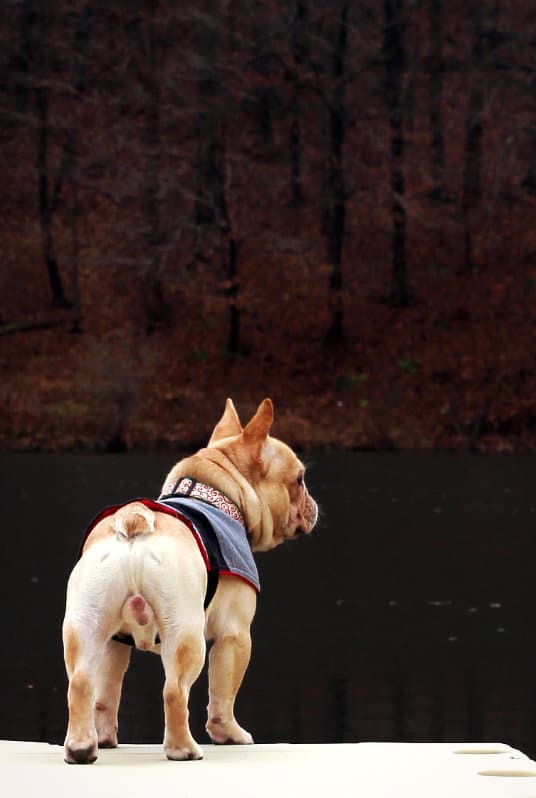Being a breeder for 15 years, we’ve not had experience with spaying or neutering dogs. We are now closing that chapter of our lives, and are looking to get our French Bulldog Louie neutered. I had no idea how many options were available. I thought it was as simple as making an appointment and suffering through healing with your dog, but that is no longer the case.

Louie is being retired as a stud dog. (Photo by Karen Dibert)
I talked to my vet about what neutering involves, and got the 411 on sterilization options available for male dogs.
“It is important to discuss your reproductive concerns with your veterinarian. There are pros and cons to neutering,” explained our vet, Dr. Stacey Sheahan of Animal Medical Center. “It reduces roaming, allows population control, can reduce some behavioral issues, and decrease risk of prostate problems and testicular cancer. The cons can be urinary incontinence and increased risk of certain cancers. Research is being done to develop safe methods for sterilization while reducing risks.”
Traditional neuter
“The traditional neuter, or orchiectomy, removes the testes,” said Dr. Sheahan. This can be done as a traditional surgery or with lasers. The laser option has advantages in terms of cauterizing, but the procedure is the same.
Scrotal ablation
Another option is scrotal ablation.This is in addition to a neuter.
“Scrotal ablation removes the scrotum as well as the testicles,” explained Dr. Sheahan. “This prevents some post-op issues in larger dogs, such as scrotal seromas and swelling. There is a lot of space left after you take the testicles.”
This makes sense in larger dogs, and may also be an option to consider for Louie. As an older dog (3 years old), his scrotum is stretched to the point where it may not shrink much after simply having a neuter.
“There are also testicular implants, such as Neuticles, if people don’t like the look of a neutered dog,” said Dr. Sheahan. Neuticles are generally implanted at the time of neutering, but can be implanted years afterward in most cases.
Vasectomy
A vasectomy is another option for dogs, and is just like the procedure for humans. The testicles remain, but the dog is unable to reproduce due to the removal of the vas deferens, which conducts the sperm from the testes. This option may not eliminate behaviors associated with an intact male. Louie has issues with mounting, so I would definitely be looking for behavior-altering options, and hope it takes care of the problem.
Zeuterin
Zeuterin is one of the newer options on the market. It is an injectable sterilization for dogs 3 to 10 months of age that kills sperm. It is considered very effective and allows a dog to keep his testicles. He will also have limited hormone production, so while there may be some behavior modification, you can’t rely on this to remove unwanted behaviors. Dogs who are Zeutered will get a “Z” tattoo to let others know he’s been altered. Louie is too old for this option, so he’ll not be getting his first tattoo with surgery. It’s kind of too bad; I may have asked them to add a heart with MOM in it as long as they were tatting anyway.
Louie heard we planned to neuter him. (Photo by Karen Dibert)
We haven’t decided, yet, which route we’re choosing for Louie, but I’m glad that I took the time to discuss options with my vet. Being educated helps me make the best decision for my dog. While it didn’t apply to our situation, you’ll also want to consult your vet about what age is best to neuter your dog based on his breed and/or size. According to Dr. Sheahan, “A lot of the recommendations are to neuter later in larger-breed dogs. Part of the reason for later is growth reasons, and there are some studies about reduction in cancers.”
The bottom line is that each dog is different. “You and your veterinarian can tailor a plan for your pet based on your pet’s needs,” said Dr. Sheahan.
The post What I’ve Learned About the Latest Neutering Methods as I Prepare to Have My 3-Year-Old Dog Fixed appeared first on Dogster.
No comments:
Post a Comment